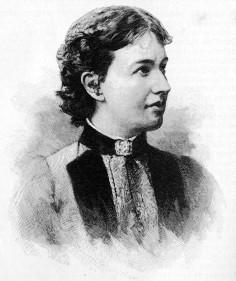Sonya Kovalevsky
Today, we meet a fascinating lady. The University of Houston's College of Engineering presents this series about the machines that make our civilization run, and the people whose ingenuity created them.
Here's a photo of a woman in her mid-thirties. She's beautiful by any yardstick -- a fine open face with full, strong features -- clear steady eyes. The woman is Sonya Kovalevsky, and she was a very complex person. Born to a tyrannical Russian general in 1850, she was both willful and shy -- brilliant and torn by self-doubt.
Little Sonya's nursery had, because of a wallpaper shortage, been covered with pages from her father's old calculus text. She gazed for hours at those pages, craving to understand them. When she reached university age she wanted to study mathematics. But Russian universities didn't accept women, and her father wouldn't let her go off to Germany alone.
So she contracted a marriage of convenience to a young paleontologist -- Vladimir Kovalevsky. And as a married woman she was able to travel freely -- first to Heidelberg and then to Berlin. Berlin was no more willing to accept women than St. Petersburg had been. But when the great mathematician Weierstrass saw her brilliance, he took her on as both a private pupil and a lifelong friend.
She finished her doctorate on partial differential equations and several other important papers before she was 25. Then she returned to her husband and to Moscow to look for work. That failed, and she tried Paris. While she was there her husband died. Finally the Swedes gave her a teaching post in Stockholm.
She lived her whole life between emotional highs and lows. And this was very evident during her seven years in Sweden. 1889 was a high. She wrote a remarkable prize-winning paper on rotating bodies, and she wrote her second novel. The novel also won high critical praise. Two years later she was deeply depressed. Then she caught flu on the way back from a trip to Moscow and died.
She was only 41, but she'd really advanced our understanding of differential equations and applied mechanics. She was the first woman mathematician in modern times to gain full academic recognition for her genius. In fact, Russia, which had been so unwelcoming during most of her life, now issued a stamp with her portrait on it.
No doubt she had in some way been badly hurt as a child. But when her father papered her room with that mad wallpaper, he awakened one of the great minds of an age. Little Sonya Kovalevsky gazed at those mystic symbols on the wall and saw what we must all eventually see -- that what one fool can do, another fool can also do. A little girl saw that those symbols weren't beyond her grasp at all.
I'm John Lienhard, at the University of Houston, where we're interested in the way inventive minds work.
(Theme music)
Osen, L.M., Women in Mathematics. Cambridge, MA: MIT Press, 1974.
Hapgood, I. F., Notable Women: Sonya Kovalevsky. Century Magazine, August 1895, pp. 536-539. This article, written by a woman with a late 19th-century perspective, paints a dreary picture of Kovalevsky's life and concludes: "... it would seem ... that a masculine head united to a feminine heart is likely to prove a very unhappy combination for a woman."
Hapgood also includes the following portrait of Sonya Kovalevsky, copied from a Russian photo and less striking than the real photo in Osen's book:
This episode has been greatly rewritten as Episode 1747.
